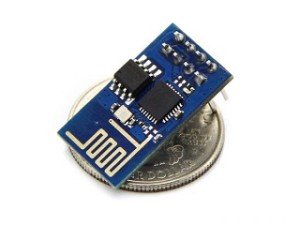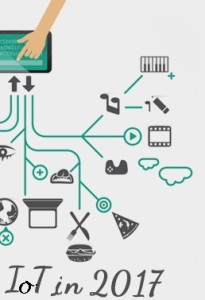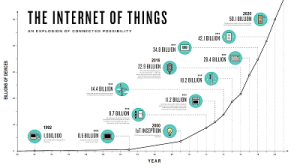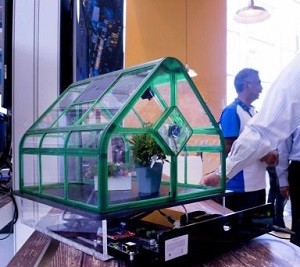
Posts Tagged ‘4G’
IoT and data security
Many aspects of data security have been developed, but there is a maxim of computing that states that no system is totally secure, and if we anticipate an exponential growth of connections to the Internet of Things, it is a fact that the security problem also has a growth In this proportion.
that states that no system is totally secure, and if we anticipate an exponential growth of connections to the Internet of Things, it is a fact that the security problem also has a growth In this proportion.
While the world of IoT has arrived (smartphones, watches, TVs, cars, glasses and other gadgets, we can say that there is a really safe IoT platform with simple operations.
To the experts, one of these basic security features is data encryption, but it must be added to the Big Data treatment, since this for the current data volume is almost indispensable, with IoT being compulsory.
IoT devices transact tons of data, cryptography is already an obvious aspect of these data, but it is still rarely used, let alone if we think from end to end, ie from producer to consumer of data, and so IoT is more gloomy.
With the advancements in quantum computing, cryptography may also not be enough to protect vital data, since quantum computers can discover cryptographic keys even faster, and algorithms though efficient now, there is no totally secure, cryptographic keys with Use of quantum computing will be more quickly opened, and while most hackers do not have access to this level of computing we can be sure, but for how long?
We must begin by rethinking two issues, BigData’s data processing and quantum-computing cryptographic keys before these features are in the hands of hackers.
Privacy data, often vital for certain systems, are and will be in check more and more
IoT and upcoming future prospects
The IoT seen as a paradigm of a changing society may change, among many other  things, cultural libraries and equipment allowing greater interaction with users and providing new services, some of which may come from applications in the clouds.
things, cultural libraries and equipment allowing greater interaction with users and providing new services, some of which may come from applications in the clouds.
Most of the objects that surround us today will be in the network in one way or another, so that you can have complete information about each one of them, it will be necessary to use repository in clouds, information sharing and data reliability.
Among the technologies for identifying objects are radio frequency identification (RFID) and sensor networks that will grow to meet this new challenge, what will be the new information and communication systems that will be present, although invisible to the user, Which will have an environment around us.
This will result in the generation of huge amounts of data that must be collected, stored, processed and presented transparently, efficiently and with intuitive interpretation by the users, ie simplicity and efficiency summarizing.
This means that model will consist of these services will become commodities as products and should be delivered in a similar way to traditional commodities.
Cloud computing should provide the virtual infrastructure for such utilitarian computing that integrates monitoring devices, storage devices and should behave both analysis tools whose foundations are found in Information Science, as visualization and delivery platforms to the customers, whose foundations are Both in Information Architecture and in Information design, this being to express beauty and help in the intuitive environment.
The model needs to consider the cost that Cloud computing offers, that is, the service must be end-user accessible to users and businesses to access on-demand applications from anywhere without the user’s chatting.
Intelligent connectivity with existing networks and computing able to use context to handle network resources will be an indispensable part of IoT.
An internet that in addition to current applications including sensors and actuators connecting the physical world should emerge consolidating IoT.
IoT’s progress is only beginning, but the period of mistrust has passed.
Chip revolutionizes IoT
A company almost bankrupt decides to invest in the development of a chip for the  Internet of Things (IoT) not only saves the company itself but promises to revolutionize the market.
Internet of Things (IoT) not only saves the company itself but promises to revolutionize the market.
The chip is the ESP8266, from Espressif company, the price $ 5 (5 collars), less than a coin and integrated in several solutions, for example, communication with the serial interface of most computer models, the UART Universal asynchronous transmission), this means transmission with which devices with TCP Internet interface.
It is a System-On-Chip with built-in Wi-Fi, It has GPIO connectors, I2C buses, SPI, UART, ADC input, PWM output and Internal temperature sensor, CPU operating at 80MHz, capable of operating at 160MHz, 32-bit RISC architecture, 32KBytes of RAM for instructions, 96KB of RAM for data, 64KB of ROM for booting, SP SP memory and Winbond W25Q40BVNIG of 512KBytes .
To program them, the company has a repository in GitHub, where it provides code samples for RTOS firmware and AT commands, and its SDK, for example, in addition there is an ESP8266 developer forum, maintained by Espressif, where it is possible Find a wide range of materials.
Will we have new developers of garages around the world?
Latin America regulate IoT or not
IoT (internet of Things) is there, cars, clocks, medical equipment and other devices  are already on the market, this should grow to the full connection between things that communicate.
are already on the market, this should grow to the full connection between things that communicate.
According to data from the 5G Americas report “Internet de las Cosas en América Latina” (made in the Spanish language), the concern over excessive regulation may impede the business model, while in Brazil, experts point to the contrary: the need for urgent regulation, Who is right?
Both of them, but it takes a matter of common sense, in general in Brazil it regulates to the shape of the pins of the outlet (a joke, but it is true), while abroad the concern is with security and standardization for everyone to adopt similar measures .
The main concern should go to the sense that it takes a lot of attention not to prevent the advancement of a new business model while ensuring more security, but without panic and exaggeration, nothing is totally safe, but of course it is necessary to adopt measures, more Equipment will mean less security.
According to the 5G Americas report, through one of its director José Otero: “The risk of excessive or ill-conceived regulation could delay the enormous growth opportunities in the Internet of Things. For this reason, it is necessary that the entire ecosystem of actors dialogue and collaborate with regulators on this important technological advance. “
According to a Machina Research consultant, Andy Castonguay, if the fragmentation and complexity of the IoT system and its many technological approaches make the deployment a challenge, it will be somewhat dangerous if regulators are prohibitive in their mandates or if they favor Technologies.
One of the main considerations regarding public policies in the sector should be made considering the sovereignty and privacy of information and for security
(Português) Pontos da IoT para 2017
IoT points in 2017 The company’s technological forecasts Gartner analyzes because the IoT (Internet of Things) has not yet kicked off, and points out some points that can make this internet happen in 2017:
because the IoT (Internet of Things) has not yet kicked off, and points out some points that can make this internet happen in 2017:
IoT security
The IoT has introduced a range of new security risks and challenges for the devices, their platforms and operating systems, communications and even systems which may or must be connected. Safety is something complicated by the fact that “things” have individual processors and their own systems, such as batteries, operating systems and devices that heat.
IoT Analytics
Analyze performance and functions in “things” is different to do on computers or smartphones because the business model is modified to the extent that will analyze information collected by things not by customer in ultimately are people, new tools and algorithms analysis are under development, but it is believed to be stable around the year 2021 should go to developing as needed.
IoT management
“Things” delay duration are not trivial, require management and monitoring.
This includes monitoring devices, software and firmware updates, diagnostics, analysis and reporting of accidents, which may cause problems in scale to the management task.
We highlight these three essentials, but now will have others that Gartner notes: Processors management in wider areas with internet connection, processes and low-power processors, platforms and operating systems for the IoT, and finally Standards and Ecosystems for IoT.
More detailed analysis is in the Gartner report ““Top 10 IoT Technologies for 2017 and 2018.”
IoT is arriving
If we have 7 billion people in the world, of which nearly 5 billion are connected, the number of devices is 50 billion and the connection between devices may be even more surprising change that has happened to the internet.
connected, the number of devices is 50 billion and the connection between devices may be even more surprising change that has happened to the internet.
The protocols until recently were reduced, now new patterns begin to emerge beyond the known BlueTooth, arrives with force now ZBee or ZigBee.
The BlueTooth also evolved into the BlueTooth Low-Energy (BLE) or Smart Bluetooth, as old and known protocol for the Internet of things remains strong, since energy consumption is a significant item for the adoption of IoT technologies.
But ZigBee is growing in number of applications and devices, and start earning much interest in developers used in automation of homes, buildings and industrial areas, use an IEEE 802.15.4 standard protocol that is an industry standard wireless technology that operates to applications in the 2.4 GHz range require little data exchange and operate a range of 100 m, so excellent for homes, buildings and industrial.
An evolution of ZBee is the standard RF4CE which has some advantages for complex systems with low power consumption, high security, robustness and high scalability with the addition of nodes and can be inserted into wireless sensor control networks for M2M applications (Machine to Machine) in the IoT.
The latest version is ZBee 3.0, which unifies all ZigBee standards into a single standard.
There are other standards will comment in the next posts.
Internet of Things in practice
Three solutions demonstrate how to use in practice the second IoT (Internet of Things) Gateways Solutions, publican in the IDGNOW online magazine.
(Internet of Things) Gateways Solutions, publican in the IDGNOW online magazine.
The first is the automation climates in homes, Automated Greenhouse Climate Control, built using multiple systems, depends on the minimum of human intervention, the system called Edge Analytics allows the climate control of a fully autonomous greenhouse allowing maximum convert both for plants, like animals and people, the conversation between the computers systems is made from results of Cloud Analytic and communication through Secure API, aiming to maximize production gain and comfort with monitoring and adjusting indoor climate, decreasing in the case of production costs.
The second is being presented today at the Transport fair Telematics & Fleet Management, which is software installed on trucks which makes it possible in addition to monitoring and position of the vehicle, perform real-time diagnostics of machine condition and can warn the driver and provide maintenance preventive vehicle, equipment Secure API is responsible for collecting, exchanging and sharing data of truck fleet with the center.
The third is a system for smart homes, called Yoga Smart Home, which connects to almost anything: Security detectors wired or wireless, cameras, thermometers, sockets and intelligent lights, entertainment systems, locks and appliances, enabling monitoring of devices from connecting to the internet.

